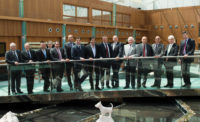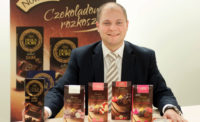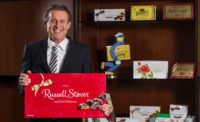In case you haven’t noticed, premium chocolate’s back. In fact, it never went away, points out Marty Thompson, Ghirardelli’s recently appointed president and ceo. True, there was a shakeout following the recession, but category leaders, such as Ghirardelli, never wavered.
Rather, sales for the company grew. Last year, the company posted a 13.4% gain. From 2005 through 2010, company sales shot up 75%. Currently, grocery sales are tracking 12% higher year-to-date. National accounts, which include mass merchandisers, drug store chains and club stores are delivering double-digit growth as well.
Thompson attributes such strong sales gains to several factors, one key being the company’s commitment to the category and its insistence on delivering consistent quality while serving up innovations in product launches, operational improvements and merchandising/marketing support. Another key is Ghirardelli’s employees – “the skills and passion of this team is incredible,” he says.
What’s even more exciting for Thompson is that there’s plenty of room for additional growth in the segment.
“The premium chocolate category in the United States accounts for 12% of all chocolate confection sales,” he says. “When you look at Canada, it’s 25%. Premium chocolate in the EU makes up 33-35% of the chocolate category.”
Given those statistics, it’s clear that there’s plenty of opportunity for the premium chocolate segment in the United States. It’s also clear to Thompson and his management staff that Ghirardelli’s mission involves leading the category to new levels of consumer acceptance.
Noting that the premium chocolate category has undergone a shakeout since the explosive years of 2006-2008, the new ceo points out that consumers still appreciate true premium experiences.
“Quality is part of our DNA; it’s part of our culture,” he adds. “It’s evident that the consumer ‘gets’ quality. Our job is to deliver that to consumers, customers.”
Chocolate companies that jumped in the premium segment but failed to deliver a true premium experience are no longer there.
“Those SKU’s are gone,” Thompson points out. In response, Ghirardelli has focused on ramping up its stable of premium products while simultaneously introducing category innovations that consumers can identify with and appreciate.
Thompson quickly rattles off several milestones to illustrate his point: the launch of stand-up bags; the introduction of cacao percentages on the labels of chocolate bags in 2005, a first for the segment; the introduction of the Intense Dark Chocolate line in 2006; establishment of a merchandising team in 2008; and the launch of Intense Dark Chocolate Sea Salt Soiree and Hazelnut Heaven in 2011.
There’s more to come, he asserts. At the end of this year and early next year, Ghirardelli will introduce two new truffle-filled recipes in the Ghirardelli Squares line - a milk chocolate piece with a dark chocolate center and a dark chocolate piece with a milk chocolate filling.
As with all its product launches, the company first conducted extensive consumer research to determine acceptance.
“We typically test about 150 consumers to see whether a flavor concept [such as Sea Salt Soiree] scores well,” explains Mona Maher, v.p. of marketing. “In this case, not only did the idea score very, very high, but the product exceeded their expectations; the flavors delighted them.”
Consumer attitudes and insights play a key role in directing Ghirardelli’s R&D efforts as well as in guiding operational and logistical investments. Moreover, it’s a critical component in spearheading the company’s ultimate goal - making Ghirardelli the premium chocolate company in the United States.
Thus, when a consumer survey reveals that 69% of all consumers agreed that the Ghirardelli brand is one they can always rely on for quality - the highest percentage amongst all other premium brands - that kind of response provides confirmation of the company’s “uncompromising” stance on quality.
That same survey of more than 1,000 consumers also shows that consumers agree that Ghirardelli delivers value more than any other premium brand.
Given the company’s Swiss parentage - Ghirardelli is a subsidiary of Lindt & Sprüngli AG - that shouldn’t be surprising. Nevertheless, it’s still very American in spirit, having been founded in San Francisco by Italian born Gold Rush fortune hunter Domingo Ghirardelli in 1852.
As Steve Genzoli, v.p. – R&D/QA, explains, “Our chocolates are crafted in an Italian/Swiss style, which means particle size is in the 16-18 micron range, the products contain high levels of cocoa butter and generally less sugar as compared to the American chocolate products we all grew up with.”
And while the company recognizes the importance of tradition and heritage, it’s even more focused on quality, consistency and continuous improvement than on history.
“We’ve made changes in our recipes, but they’ve been made to improve the flavor profiles, improve the quality of the product,” he says. “For example, although we are true to the roots of the recipes, we’ve increased cocoa butter content as well as milk fat content to create better tasting products and to improve the melting profile.”
The push toward continuous improvement begins at the very source - cocoa beans - which come primarily from West Africa and South America. Nearly 30% of all beans offered to the company’s headquarters and manufacturing facility in San Leandro, Calif., are rejected, however.
“We do reject a large percentage of the cocoa beans that are offered to us because they simply do not have the flavor profile we demand” Genzoli says.
Those profiles take on additional importance as the company blends the beans to create its distinctive chocolate flavor combination.
“With blends, you can make a more sophisticated chocolate as opposed to using single origins, which can be monotone in nature,” he says. “With blends, we can extract certain characteristics to deliver a more complex flavor profile.”
And increased sophistication is what the American consumer wants, at least in the premium chocolate category, asserts Maher. Take for example that two of three of Ghirardelli’s top selling items in the grocery segment involve dark chocolate: 60% Dark Squares Chocolate in standup bags and the 72% Intense Dark Chocolate bar.
Ghirardelli’s success in the dark chocolate arena within the premium chocolate segment can be traced to the company’s total involvement in the process, from sourcing and roasting beans to refining and conching them.
“For all of our chocolate products, it’s very important for us to be able to control quality at every single step in the cocoa to chocolate process,” says John Dodge, v.p. – operations. He underscores the fact that Ghirardelli has “phenomenal assets” regarding cocoa bean processing and chocolate production.
“The Ghirardelli factory is full of very modern and well-maintained high-speed equipment.”
The 272,000-sq.-ft. plant, which employs 200 production workers, features a Barth roasting system, eight Buhler refiners and five Frisse as well as two Petzholdt conches.
As Genzoli points out, “Having the know-how of roasting is key to flavor development. It’s something we simply must control. Most of the major chocolate players in the United States outsource their roasting.”
In chocolate processing, there are three chocolate moulding lines (all Bindler) and three chocolate chip depositing lines (two National and one Aasted). The moulding lines - depending upon the product being made - feed hi-speed ACMA flow wrappers rated at 1,000 pieces per minute or Bosch Sig bar wrappers operating at 140 – 160 bars per minute.
The chocolate chip lines feed either Triangle or Eagle bagging systems, the units ranging between 40 – 50 bags per minute.
At the moment, Dodge is overseeing a configuration change to one of the Bindler lines originally designed to do both Squares pieces and bars.
“We’re going to dedicate the line to Squares production, which not only involves reconfiguring the existing wrapping assets, but also modifying the moulding line itself,” he says. As a result of the changes, we’ll improve changeover times and reduce waste levels.”
Those improvements stem from the company embracing a continuous improvement philosophy, one that seeks to combine elements of Kaizen and lean manufacturing.
“Our focus is to be highly efficient while simultaneously improving quality,” Genzoli adds.
Another area in which the company looks to implement change is food safety. At a recent meeting in Switzerland, the Lindt Group committed the organization to implementing FSSC 22000, which is recognized under the Global Food Safety Initiative (GFSI).
“Our first step is to do a gap analysis of our current quality systems, which we believe are already well-developed,” Genzoli says. “From that gap analysis, we will chart a course for certification. Our goal has always been to continuously improve our quality and we see this commitment towards FSSC 22000 standards as a vehicle to help challenge us. We don’t believe the conversion will be an enormous undertaking, since we already have several unannounced audits as well as customer audits throughout the year. Nevertheless, those are just snapshot approaches versus a more comprehensive system approach which we’re looking to implement.”
The price tag behind such improvements isn’t inexpensive. For the last three to four years, annual capital expenditures have totaled $8 million, says Dodge. They are part and parcel, however, of an ambitious goal, namely becoming the leading premium chocolate company in the United States.
Consider the time and effort spent on developing the Intense Dark Sea Salt Soiree, a dark chocolate recipe featuring sea salt and almonds as well as soon-to-be launched truffle-filled Squares chocolates.
“Most people think that sea salt is a fairly common ingredient,” explains Genzoli. “They fail to realize that each sea salt has different flavor characteristics, depending where it is sourced. Then there’s the particle size, which also plays a role.
“On the almond side, we were also very particular about how the California almonds were roasted. All in all, it took a year to develop a bar we were happy with it.”
With the truffle-filled recipes, the hurdles were of a different nature.
“This is the first time we’ll be depositing a fat-based filling as opposed to a water-based filling on our lines,” he continues. “Because these fillings have a complex fat matrix, they require special tempering.”
Nothing insurmountable, but certainly a learning curve for operators used to water-based fillings.
Ghirardelli’s line operators aren’t the only ones faced with learnings on the company’s journey toward becoming America’s leading premium chocolate supplier though. Consumers are in need of being reminded who Ghirardelli is.
“We have to let consumers know we are in the business, whether it’s at the shelf, at the point of sale or during the season,” says Thompson.
One of those ways is through advertising and promotions. Over the last three years, the company has more than doubled its marketing support with plans to invest more than $25 million in 2011. Earlier this quarter, the company launched a new 30-second spot dubbed Rendezvous, which shows a woman in her home office enjoying a well-deserved break by having a Ghirardelli Squares chocolate.
“Our target consumer is a female, aged 25-54,” explains Maher. “She’s what we call our ‘Leading Lady,’ a woman who’s either a mom or a professional [or both] that’s juggling several things in her life. This commercial emphasizes the everyday reward nature of premium chocolate.”
Another way Ghirardelli seeks to remind consumers of the premium nature of its products is through sampling. Anyone who’s visited Ghirardelli Square and the company’s retail shop knows about the sampling program - all visitors are given a Squares chocolate as part of the experience, one that encompasses not only offering a broad array of everyday and gift chocolate items, but also an opportunity to sit down and enjoy a menu featuring ice cream, sundaes, coffee or hot chocolate.
Currently, the company has 16 ice cream and retail shops and plans to open two more this year, a move that underscores its goal to touch the consumer in a different manner.
In addition, the company will launch a promotion dubbed Pleasure Squared, which asks consumers to share their moments of pleasure consuming Ghirardelli chocolates.
“We plan to distribute 1.5 million samples using street teams in metro areas and also locations near top retailers,” Maher adds. “We want to integrate premium chocolate into their life.”
A classic way of doing so, of course, is during seasonal occasions. Here, Ghirardelli has truly connected with the American consumer with its Peppermint Bark offering. Launched in 2003, the Christmas-themed flavor combination has become a “hero” for the company’s seasonal sales. In conjunction with its philosophy of growing the category, the company will be releasing a new Peppermint Bark television commercial this season. Work has also commenced on Easter-related products.
As Thompson points out, premium chocolate products account for 15% of all Christmas and Valentine’s Day sales. Premium chocolate items, however, only represent 5% of Easter purchases.
“There’s plenty of white space there,” he says. “We want to take that season to another level.”
An example of Ghirardelli’s ability to raise a segment or category to another level can be seen in the both the baking ingredient and foodservice sectors.
“We are the No. 2 supplier of baking chocolate in America,” Thompson says. “We’re the No. 1 supplier of premium chocolate chips, with more than a 13 share of the overall baking chocolate category.”
Ghirardelli also is working hard with retailers so they understand how to manage the premium chocolate category. Patrick High, director of grocery sales, points out that with the departure of many of the major chocolate manufacturers, Ghirardelli has sought to fill the void as a premium category captain.
“We are experts in premium chocolate,” he says. “We have tremendous information regarding consumer insights, category data, tool kits, Nielsen information, consumer decision trees and more. And, because of our parent Lindt, we also have global insights, which allow us to follow what’s happening in Europe and translate that into learnings here.
Steve Blair, director of national accounts, echoes High’s comments. He points out that the company created an oversight/analytics group two years ago, which provides the support necessary to further grow the premium category.
“Everyone understands the opportunity in the United States, the fact that the premium chocolate category is underdeveloped,” he says. “We’re investing in growing premium because it offers retailers a higher dollar ring, higher margins and a diversified consumer base. It’s a right to win.”
To showcase its commitment, Ghirardelli is working 18 months out on seasonal programs with some major accounts.
“That’s typically unheard of with companies our size,” Blair says. “We may have only a 2.3 share of the chocolate market, but we’re behaving like a 30-share company in what we offer our customers.”
In the end, the chocolate premium category offers up both consumers and customers a tempting invitation: For consumers, the satisfaction of self-reward with an extremely good tasting and pleasurable product; for retailers, more pennies on the dollar and accelerated growth.
On Ghirardelli’s end, the company wants to ensure everyone gets to the party and enjoys the opportunity to the fullest. After all, as its motto says, it simply wants to provide everyone with “moments of timeless pleasure” through premium chocolate. Moreover, it’s working.
At a Glance
Ghiradelli
Headquarters: San Leandro, Calif.
Employees: 800
Sales: $320 million (Candy Industry estimate)
Products: Moulded chocolate items (pieces, bars); baking chips
Brands: Ghirardelli, Squares, Intense Dark, Luxe Milk
Plant: 272,000 sq. ft.; six lines (three moulding; three chip depositing lines)
Output: 29,000 annual tons
Management team: Marty Thompson, president & ceo; Steve Genzoli, v.p. – R&D/QA; Mona Maher, v.p. – marketing; John Dodge, v.p. – operations; Martin Hug, cfo; Yvo Smit, v.p. - restaurant & retail.
Captions: Marty Thompson, Ghirardelli’s new president and ceo, offers up a hot fudge sundae as well as several chocolates at the company’s ice cream and retail shop in Ghirardelli Square, San Francisco.
Ghirardelli Chocolate Co.’s management team: Standing (l. to r.): Martin Hug, cfo; Marty Thompson, president and ceo; Steve Genzoli, v.p. - R&D/QA. Seated: Mona Maher, v.p. - marketing; and John Dodge, v.p. - operations.
Nearly 30% of incoming cocoa beans are rejected by the company because they don’t meet quality and/or flavor profiles. Vicki Wong, senior food technologist, tempers 72% chocolate in preparation for making samples as Steve Genzoli, v.p. - R&D/QA looks on. Cynthia Tjhia, R&D technologist, prepares a new flavor prototype for sensory testing.
Jan Gucwa, production supervisor, checks on the Aasted tempering unit that pumps chocolate to the Bindler moulding line. Kim Lewis, production supervisor, discusses with John Dodge, v.p. - operations, the specific capabilities of the Bindler line, which can handle 22-25 moulds per minute.
During the past three to four years, Ghirardelli Chocolate Co. has spent about $8 million annually on improving efficiency and quality at the 272,000-sq.-ft. plant.
Mona Maher, v.p. - marketing, says the company conducts extensive consumer research regarding new product introductions. It also does heavy product sampling at all of its 16 retail stores (Ghirardelli Square shop pictured), giving out Squares chocolates as part of the chocolate experience.





